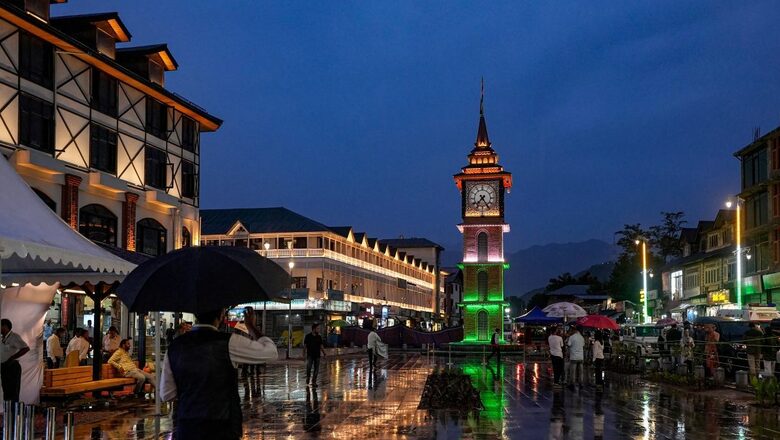
views
It has been five years since Article 370 was nullified. We, born in the Valley and who survived the more than three-decade-long proxy war sponsored by the ISI and the Pakistan military-industrial complex, were assured that no political party would touch the Articles, and any party that did would be committing political suicide. However, the BJP came with its election manifesto and demonstrated its political will to resolve the Kashmir imbroglio.
The Indian Supreme Court, in a unanimous decision, upheld the abrogation of Articles 370 and 35A of the Indian Constitution, which were related to the special status of Jammu and Kashmir. The court found that Article 370 was a temporary provision and that the President had the authority to abrogate it. The court also directed the Election Commission to conduct elections in Jammu and Kashmir by September 30, 2024, and to restore its statehood.
The associated trauma of this armed conflict never truly goes away. The people of the Valley include bereaved parents, grandparents, widows, half-widows, and orphans trying to heal and move on, with two generations of our youth buried six feet under and a third generation radicalised with anti-India sentiments. The mental health statistics of the Valley are alarming, with a severe shortage of psychiatrists and psychologists to treat the thousands of distressed, depressed, and anxious patients suffering from various disorders. The health statistics are equally discouraging, as years of confinement due to the strike (hartal) calendar of separatists and armed terrorists have taken a significant toll.
Cardiac problems, diabetes, and spinal deformities, compounded by mental health issues, have left the population struggling to cope with the devastation caused by terrorism and the soft separatism of politicians. Today, schools, colleges, offices, and institutions functioning normally offer some semblance of peace to ordinary people, low-income groups, and the middle class. However, the elite of the Kashmir Valley have largely remained unaffected, either staying away from the jihad or acting as keyboard warriors from places like Turkey, Qatar, and leftist bastion universities in the West, while the children of low-income and socio-economically disadvantaged families have suffered and died.
The improving infrastructure—such as buildings, roads, highways, developmental projects, rail services, and airport upgrades—signals prosperity and progress. For the average Kashmiri, there are two main areas of interest: one is the boost in the economy, as tourist arrivals continue to break records, and the second is the ongoing raids by the NIA and SIA dismantling the OGW (overground worker) network every week. This network consists of former terrorists and Jamaat cadres embedded in the bureaucracy, media, police, and other institutions.
This Muharram saw young and old from both Shia and Sunni communities, displaying fervour for the martyrdom of the Prophet’s grandson Imam Hussein at Karbala, a ritual significant to both sects. Sunnis lined up alongside the roads, providing refreshments to the flagellating Shias. Notably, the ambulance drivers, nurses, and health workers escorting the procession were mostly Sunnis. Many Shias, interviewed on camera, remarked that the event felt reminiscent of the 1980s, before the Valley’s descent into Islamist warfare. The sight of such unity delighted youths, who found the stories told by elders about Muharram processions of the 1980s coming to life. Srinagar city also elected a Shia cleric from the National Conference in the Assembly elections this year.
The Ahmadiyyas living in the Valley continue to practice their beliefs freely without any threats. This serves as evidence that for the diversity within Islam to be preserved and flourish, there is no better guarantee than the Indian State and the Indian Constitution. Even agnostic Muslims, who are increasingly voicing dissent against the Wahhabization of Islam and its rigidity imposed by mullahs and gatekeepers of morality, are gradually finding space to express their opinions. It is a different story that they had to undergo a different kind of terrorism called ‘takfiri terrorism’ – the practice of labelling others as not Muslim enough or apostates.
Article 25 of the Indian Constitution guarantees the right to practice and propagate religion to all its citizens. Since the abrogation of Article 370, the Indian Penal Code (IPC) extends to the entire Union Territory of Jammu and Kashmir. Previously, Kashmiri Christians celebrated Christmas, Easter, and other holy days in a low-key manner, fearful of inviting the attention of the jihadi groups. However, in the five years since the abrogation, they have felt empowered to observe their holidays openly. Kashmiri Sikhs have similarly embraced their religious freedom, expanding their gurudwaras and maintaining them with renewed confidence. While Srinagar city and other towns boasted several Buddhist monasteries in the 1980s, many were later converted into residential complexes or business ventures. There is hope that these monasteries might be revived in the coming years, even as the Union Territory of Ladakh is flourishing with its own university, airport, various upcoming educational establishments, and sports complexes.
The Islamic State of Pakistan failed spectacularly in their agenda of Ghazwa-e-Hind, or “bleeding India with a thousand cuts.” They tried to complete the unfinished business of Partition by funding an internal armed insurgency with our disgruntled youth for a merger with the “Land of the Pure,” ethnically cleansing the Kashmiri Pandits from the Valley in the process. Today, the new generations of Kashmiri Muslims are gradually learning this truth as peace solidifies and the economy stabilises. It is now possible to tell them how the Indic civilisational fold has, since ancient times, given refuge first to the persecuted Persians (Zoroastrians), the Prophet’s family (defended by Raja Dahir of Sindh), the Tibetans, the Baloch, the Afghans fleeing the Taliban, and even absorbing Siddhi Yemenis down South (Arabs since the advent of Islam through trade in South India).
Islam itself has been transformed by dharmic traditions, religions, and philosophies to create a unique syncretic Indic Islam. Prime examples include APJ Abdul Kalam, the Missile Man and 11th President of India; Hamid Dalwai; Havildar Abdul Hamid; Arif Mohammad Khan; Bollywood stars; cricket celebrities; and numerous members of civil society. The new generation of Kashmiris is in the process of relearning and unlearning decades of Islamic jihad and Wahhabization. This transformation requires more time before the Government of India considers the Valley ready for Assembly elections.
The author is a writer and an educationist from Srinagar. Views expressed in the above piece are personal and solely those of the author. They do not necessarily reflect News18’s views.
















Comments
0 comment